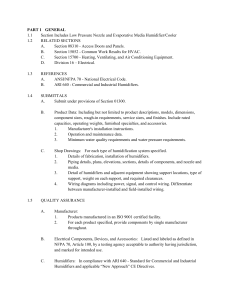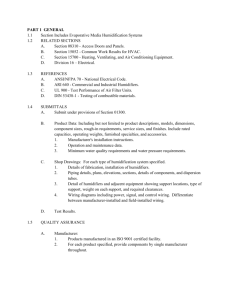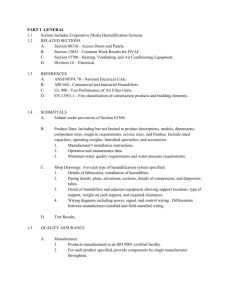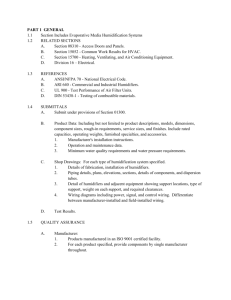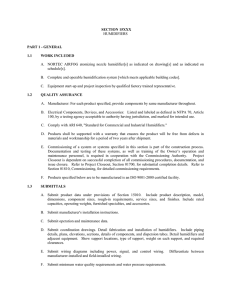DL Type B Specification
advertisement
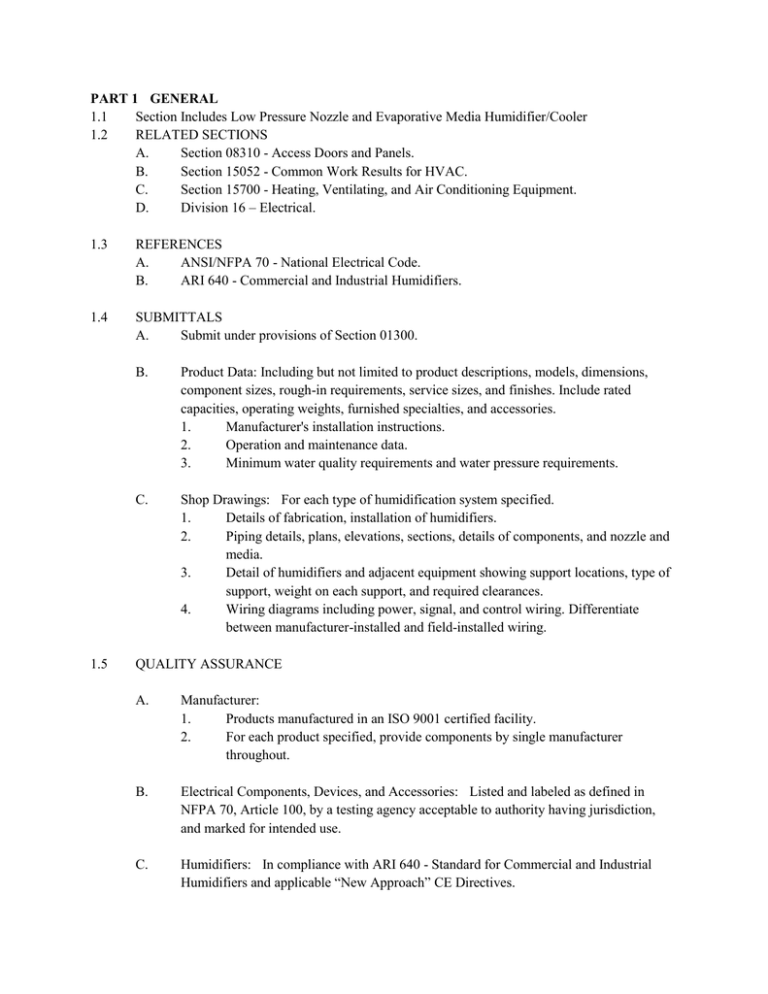
PART 1 GENERAL 1.1 Section Includes Low Pressure Nozzle and Evaporative Media Humidifier/Cooler 1.2 RELATED SECTIONS A. Section 08310 - Access Doors and Panels. B. Section 15052 - Common Work Results for HVAC. C. Section 15700 - Heating, Ventilating, and Air Conditioning Equipment. D. Division 16 – Electrical. 1.3 REFERENCES A. ANSI/NFPA 70 - National Electrical Code. B. ARI 640 - Commercial and Industrial Humidifiers. 1.4 SUBMITTALS A. Submit under provisions of Section 01300. 1.5 B. Product Data: Including but not limited to product descriptions, models, dimensions, component sizes, rough-in requirements, service sizes, and finishes. Include rated capacities, operating weights, furnished specialties, and accessories. 1. Manufacturer's installation instructions. 2. Operation and maintenance data. 3. Minimum water quality requirements and water pressure requirements. C. Shop Drawings: For each type of humidification system specified. 1. Details of fabrication, installation of humidifiers. 2. Piping details, plans, elevations, sections, details of components, and nozzle and media. 3. Detail of humidifiers and adjacent equipment showing support locations, type of support, weight on each support, and required clearances. 4. Wiring diagrams including power, signal, and control wiring. Differentiate between manufacturer-installed and field-installed wiring. QUALITY ASSURANCE A. Manufacturer: 1. Products manufactured in an ISO 9001 certified facility. 2. For each product specified, provide components by single manufacturer throughout. B. Electrical Components, Devices, and Accessories: Listed and labeled as defined in NFPA 70, Article 100, by a testing agency acceptable to authority having jurisdiction, and marked for intended use. C. Humidifiers: In compliance with ARI 640 - Standard for Commercial and Industrial Humidifiers and applicable “New Approach” CE Directives. 1.6 1.7 1.8 COMMISSIONING A. Commissioning of system or systems specified herein is required. Provide personnel and equipment to facilitate commissioning process. B. Documentation and testing of these systems, as well as training of the Owner’s operation and maintenance personnel, is required in cooperation with the Commissioning Authority. C. Project Closeout is dependent on successful completion of all commissioning procedures, documentation, and issue closure. DELIVERY, STORAGE, AND HANDLING A. Deliver all materials in their original sealed containers bearing manufacturer's name and identification of product. B. Do not store products in location with conditions outside manufacturer's absolute limits. C. Materials delivered to the site shall be examined for concealed damage or defects in shipping. Defects shall be noted and reported to the Owner’s Representative in writing. PROJECT CONDITIONS A. 1.9 Coordinate location and installation of humidifiers in ducts and air-handling units in the space it serves with the electrical, mechanical, and plumbing contractors. Revise locations and elevations to suit field conditions and to ensure proper humidifier operation. WARRANTY A. Manufacturer’s Standard Warranty: Two year warranty covers defects in materials and workmanship, commences on date of shipment. PART 2 PRODUCTS 2.1 MANUFACTURERS A. Acceptable Manufacturer: NORTEC; 826 Proctor Ave. P. O. Box 698; Ogdensburg, NY 13669. Toll Free: 866-NORTEC-1. Email: nortec@humidity.com. Web: www.humidity.com. B. Acceptable Manufacturer: Condair Ltd; Talstrasse 35-37, CH-8808 Pfäffikon Ph. +41 55 416 61 11, Fax +41 55 416 62 62 info@condair.com, www.condair.com C. 2.2 A. Substitutions: Not permitted. IN-DUCT LOW PRESSURE NOZZLE AND EVAPORATIVE MEDIA HUMIDIFIER/COOLER Series: DL Series humidifiers as manufactured by NORTEC / CONDAIR. The Nortec DL, low pressure nozzle and evaporative media humidifier system is configured to operate on Reverse Osmosis (RO) or De-ionized (DI) Water supplied by others. B. General: 1. Pre-engineered system, for air handler/duct application, uses low pressure nozzle technology to directly inject fine mist into the airstream with a ceramic evaporative media downstream for additional evaporation and mist elimination. 2. Humidifier minimum installation length of 23.6” (distance from nozzle grid to ceramic media) 3. Humidifier accepts reverse osmosis and de-ionized water (<15μS). 4. Low pressure nozzles to operate between 29 and 101.5 psi (2-7 bar). 5. Evaporative media to be porous ceramic material designed for post evaporation and mist elimination. 6. Electronic controller, which monitors the operation of the system, controls output levels and initiates self-cleaning and flush cycles to ensure hygiene operation. 7. Humidifier powered by 100-240 volts single phase power supply. 8. Hydraulic system to supply water to the low pressure nozzles with 7 stages of control. 15 stage control available as an option. 9. Duct shall contain nozzle grid, connection hoses, and ceramic media. Pumps, valves, controls, and other mechanical components shall be provided in a separate module for installation external to the air stream. 10. Control panel includes Modbus interface for integration into building automation system. BACnet, LonWorks, available as options. C. Nozzle Grid: 1. Pre-assembled nozzle grid sections with color coded nozzle assemblies for easy connection to staging solenoid valves. 2. 316SS Low pressure nozzles with capacities of: 3.3 lbs/hr (1.5l/hr), 5.5 lbs/hr (2.5l/hr), 6.6 lbs/hr (3.0l/hr), 8.8 lbs/hr (4.0/hr), or 11 lbs/hr (5.0l/hr) 3. Nozzles spray angle can be adjusted into (4) positions to prevent condensing on AHU walls. 4. Threaded nozzle connections. All other connections to be push fit quick connections. D. Evaporative Media: 1. Media: Made of porous ceramic material, absolutely free of fiberglass. 2. Replacement: Individual removable tiles. 3. No tools required for media removal. 4. Rate of Evaporation: Dependent on the air volume, air temperature, and installation distance from nozzle grid. E. Mist Eliminator: 1. Additional droplet separator required if air velocity exceeds the allowable limit. 1. DL without additional mist eliminator allows velocities operation up to 590 fpm (3.0 m/s). 2. DL with additional mist eliminator allows velocities operation up to 787 fpm (4.0 m/s). F. Management System: 2. Microprocessor control using a proportional-integral method for interpreting analog signals from a humidistat and or building control systems. 3. The controller determines which stages should be activated to meet humidification loads. 4. The controller activates self-maintenance cycles. This includes controlled flushing of the water supply lines, and drain cycles to maintain cleanliness of the water loop. 5. Control panel complete with on/off switch, auto drain switch, and LCD touch screen for fault, maintenance, and operational indication. G. Control panel with backlit Touch Screen Display to have the following functionality: 1. Service indicator and LED power on. 2. Intuitive touch screen back-lit graphic display. 3. Display of relative humidity and set point. 4. Display of operating hours. 5. Capacity output. 6. Real-time date and time. 7. Error history indication. 8. Limited capacity adjustment. 9. Inlet flush and line purging. 10. Adjustable maintenance intervals and alarms. 11. Remote relay testing. 12. Modbus standard host protocol. 13. Terminal block installed for easy field connection s. H. Humidity Control Methods: 1. Humidistat/thermostat or BMS control. 2. Accepts standard modulating control signals. 3. On/Off, 24 VAC safety loop for On/Off control, air proving, and/or high limit. I. Hydraulic Assembly: 1. Packaged Hydraulic Assembly: Shall be installed external to airstream and include all components required for circulation water including; optional pump, Hygiene Plus Silver Ion canister, staging valves, sensors, and drainage system. 2. A maximum of 15 stage control shall be available as an option, 7 stage standard and controlled by up to (5) 24Vdc solenoid valves. 3. Optional VFD controlled pump in DL Type A systems. 4. Optional sterile filter. 5. Water jet pump to allow for draining of the nozzle supply lines. 6. The hydraulic unit shall include a Hygiene Plus canister to actively does the supply water with silver ions as a means of bacteria control. 7. Inlet valve, pressure gauge and sensor to ensure correct supply water pressure of 43.5-101.5 psi. 8. Standard conductivity sensor to monitor supply water conductivity. Control panel to trigger alarm if conductivity increases above allowable limit. J. Aerosol Breakdown and Hygiene Control: 1. Management System capable of real-time flushing, purging and cleaning cycles via the Management System control panel. In the event of no call for humidity, humidifier shall drain all water from the nozzle supply lines. 2. Humidifier Operation: Aerosol-free operation guaranteed under maximum air velocity of 787 fpm (4.0 m/s). K. Optional Features/Accessories: 1. Secondary mist eliminator. 2. VFD controlled booster pump. 3. 15 Stage step control. 4. Remote fault indication board. 5. Integrated sterile filter. 6. Leak detection sensor. 7. H202 Hydrogen peroxide dosing system. 8. Silicone free. 9. Central rack for control panel and hydraulic unit. 10. Compressed air flushing connections. 11. On/Off digital duct high limit humidistat. 12. Air proving switch. 13. 10V Digital Duct Humidistat package. 14. 0 - 10V Digital Wall Humidistat. 15. 2-10V Digital Wall Humidity Sensor. 16. 2-10V Duct Humidity Sensor. L. Model: NORTEC / CONDAIR DL Low Pressure Nozzle and Evaporative Media Humidifiers/Coolers. PART 3 EXECUTION 3.1 EXAMINATION A. Examine ducts, air-handling units, and conditions for compliance with requirements for installation tolerances and other conditions affecting performance. B. Examine roughing-in for piping systems to verify actual locations of piping connections before humidifier installation C. If preparation is the responsibility of another installer, notify Architect of deviations from manufacturer’s recommended installation tolerances and conditions. D. E. Do not proceed with installation until substrates have been properly prepared and deviations are corrected. Commencement of installation constitutes acceptance of conditions. 3.2 INSTALLATION A. Install components plumb and level, in accordance with approved shop drawings, product installation details and manufacturer’s recommendations. 1. Install humidifiers and components per manufacturers' instructions. 2. Seal humidifier duct penetrations with flange. 3. Install with required clearance for service and maintenance. 3.3 TESTING AND ADJUSTING A. Manufacturer's Field Service: Engage a factory-authorized service representative to inspect field-assembled components and equipment installation, including piping and electrical connections. B. Test Results: Reported in writing to Architect. 1. Leak Test: After installation, charge system and test for leaks. Repair leaks and retest until no leaks exist. 2. Operational Test: After electrical circuitry has been energized, start units to confirm proper unit operation. Remove malfunctioning units, replace with new units, and retest. 3. Test and adjust controls and safeties. Replace damaged and malfunctioning controls and equipment. 3.4 TRAINING A. Engage a factory-authorized service representative to train Owner's maintenance personnel to adjust, operate, and maintain humidifiers. 1. Train Owner's maintenance personnel on procedures and schedules for starting and stopping, troubleshooting, servicing, and maintaining equipment and schedules. 2. Review data in maintenance manuals. 3. Schedule training with Owner, through Architect, with at least seven days advance notice. 3.5 PROTECTION AND CLEANING A. Protect humidification system components from damage until date of substantial completion. B. Repair or replace damaged components that cannot be repaired. C. Remove temporary protective coverings, excess materials. END OF SECTION
